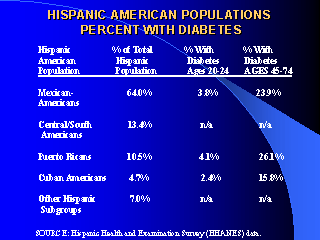|
|
|
|
front |1 |2 |3 |4 |5 |6 |7 |8 |9 |10 |11 |12 |13 |14 |15 |16 |17 |18 |19 |20 |21 |22 |23 |24 |25 |26 |27 |28 |29 |30 |31 |32 |33 |34 |review |
 |
Mexican-Americans represent the largest Hispanic American subgroup with 64
percent of the Hispanic population. Central and South Americans represent the
second largest Hispanic American subgroup, with 13 percent of the Hispanic
population.
For decades health professionals have been concerned with the health status among the residents of various regions on both sides of the U.S.-Mexico border as well as the people moving between the United States and Mexico. The United States and Mexico share a 3000 kilometers long border, 64% of which is marked by the Rio Grande River. Along this vast stretch, from San Diego/Tijuana on the Pacific Coast to Brownsville/ Matamoros on the Gulf of Mexico, are 14 pairs of cities - 28 in all. Moreover, the 1980 U.S. census estimated that some seven million persons lived in U.S. counties and Mexican municipios along the border. The census counted almost four million inhabitants in the 24 counties on the U.S. side and three million in the 33 municipios on the Mexican side of the border. Of these, some 3.8 million lived in the 12 most populated U.S. counties and 2.5 million lived in the 12 most inhabited Mexican municipios. These figures have undoubtedly increased dramatically since the last count, because the worsening Mexican economy has prompted many more Mexican nationals to migrate to the more prosperous border cities - sites of the U.S. industry-established "maquiladora" plants. |